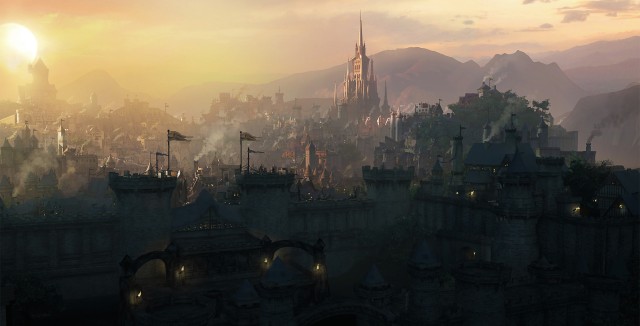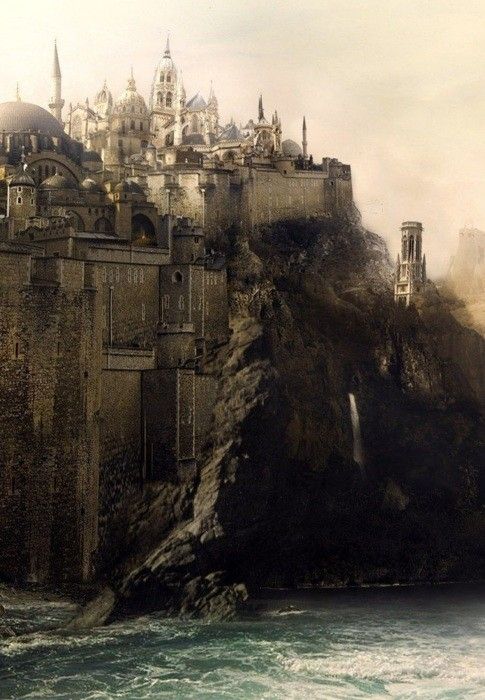
In this semi-regular (probably in fact very irregular) series of posts, I’ll note some of the more important modifications I’ve made to the Warhammer setting for the purposes of my campaign.
The city of Middenheim is one of the elements of the setting that, as written officially, never made much sense to me (as I’ll get back to in the closing comments). This is my attempt at a slightly more plausible reimagining of the city and its surroundings. It’s not a complete writeup of the city, more like a summary of how my version of it differs from the canonical.
Political basics
(These points will probably be further developed in a future post, but here’s some bits I’ve decided on already.)
- The Principality of Middenheim, ruled by Kurfürst (Elector-Prince) Boris Todbringer, is one of the four great “city-states” of the Empire. The Kurfürst is also the liege lord of the Grand Barony of Nordland.
- The Principality consists of the City of Middenheim itself and surrounding lands, extending about 50-60 miles in each direction from the central city. The territory is small but has a high proportion of farmland. There are a number of other towns and small cities (up to a few thousand inhabitants each) in the Principality, but no other large cities.
- The City of Middenheim itself has a population of perhaps 40,000, making it the fourth largest city of the Empire (after Altdorf, Nuln and Talabheim). The total population of the Principality is roughly ten or fifteen times that number.
- The Kurfürst is an autocrat running the principality with few formal checks on his power. In practice, he relies heavily on his advisors and ministers. As for the city of Middenheim itself, much of its day-to-day running is left to the Magistrates, a council of prominent (non-noble) citizens. The Magistrates head and coordinate the Public Commissions, a series of offices responsible for various aspects of the city. They are subordinate to the Kurfürst but for the most part he doesn’t interfere in the everyday running of the city apart from passing new laws.
- In the wider perspective, the Kurfürst is subordinate only to the Emperor – and even that is fairly theoretical. He’s also the Imperial Warden of the North, meaning that in wartime he can raise and command armies from Nordland, Middenland and/or Ostland as needed.
Geography

(I’m working on a map to illustrate all this, but it’s taking forever and I decided not to hold up the post for it. I’ll add it eventually when it’s finished.)
- The city of Middenheim itself sits on a huge, squat mesa, the Fauschlag Rock. The Fauschlag lies at the very westernmost end of the Midden Mountains, separated from the mountain chain by a chasm.
- The Fauschlag is about 300 feet (90 meters) tall and almost vertical. The plateau forming its top is relatively flat and about a mile across.
- The vitally important Salz river begins as a stream high in the Midden Mountains, joining many other mountain streams into a river. It forms a small lake, like a moat, around the Fauschlag and runs north through Nordland, past or through Arenburg, Beekerhoven and Salzenmund, finally running into the Sea of Claws at the great port of Neue Emskrank. The Salz is navigable from Middenheim on, and by way of the seaport it’s a crucial link between Middenheim – and the northwestern Empire in general – and the greater world outside.
- Middenheim’s harbour sits on the lake at the foot of the Fauschlag, much like in Kemperbad, and with a similar system of lifts up to the top. The shanty town of Warrenburg has grown up around the harbour and spread around the lake.
- Around the rock and the lake there’s plenty of farmland and villages, most closely clustered along the rivers and roads – along the main roads you’ll pass a village every couple of miles – and interspersed with forested hills. East of the city, the wooded foothills of the Midden Mountains are more inhospitable ground.
- Three great viaducts lead up from the main roads to the southern, western and northern city gates. They begin about half a mile away (but they’re a bit longer as they zig-zag their way up), sloping gently upwards. The viaducts are about 26 feet (8 meters) wide and have two lanes to allow two-way traffic. A fourth, smaller and steeper, viaduct from the eastern gate crosses the chasm into the mountains. The alternate way into the city, usual for travellers arriving by river, is the lifts from the harbour.
- Several other streams and minor rivers, flowing down from various hills and mountains, run to join the Salz at the Fauschlag lake or other points. The most important are the Schöning river, running north from the Drakwald past Schöninghagen and into the Fauschlag lake, and the Lindenbach, running down from the Lindenheim mines in the Blackstone hills northeast of Middenheim.
- Aside from the Salz running along the foothills, several mountain streams join with snowmelt to form a great waterfall from the eastern side of the chasm – just a few yards higher than the top of the Fauschlag – into the Fauschlag lake. A series of aqueducts also cross the chasm, leading water into the huge cisterns cut into the rock. Which brings us to…
Water supply and sewers
- The most important source of pure water is a high vale in the mountains east of the city. There’s a huge dammed reservoir catching snowmelt and water falling on a wide area, about a hundred yards higher than Middenheim.
- Three parallel aqueducts (mostly buried under the ground) convey the reservoir water to the city. A number of huge water cisterns are dug within the Fauschlag rock itself.
- Within the city, water is brought by underground stone and metal pipes to various wells and pumps. Some buildings also have their own cisterns for easier supply.
- Underneath the city streets is an extensive sewer system. Sewage is carried off directly to be dumped in the Salz, while (relatively) cleaner water is used for powering water wheels and various processes such as the lifts before eventually also ending up in the lake or river.
- Maintaining the aqueducts, water wheels and pumps – and overseeing matters of water supply and drainage in general – is chiefly done by the Engineers’ Guild. This is vitally important to the city, of course, and its water supply system is the most impressive of its kind in the northern Empire at least. (And it makes the new punitive taxes on the Guild all the more surprising…)
Food supply and economics, very briefly
- The city of Middenheim, of course, can produce little of its own food supply and imports most of it, both from the surrounding farmlands and from further afield (again the river Salz is vital for bringing imported supplies from Nordland). Some 250 loaded wagons enter the city every day just to bring foodstuffs.
- Middenheim’s connection to the Sea of Claws – by way of Nordland, also under the Kurfürst’s control – makes it an important transit point for trade. Middenheim is the furthest point inland that can be reached by sailing up the Salz river.
Sources and inspirations
- The point of departure, of course, is the official WFRP material on Middenheim like the 1E and 4E Middenheim sourcebooks, Middenheim: City of Chaos and Middenheim: City of the White Wolf, and both versions of Power Behind the Throne.
- The section on water supply is largely based on Iron Crown Enterprises’ old Minas Tirith book for Middle-Earth Role-Playing (I. C. E., 1994).
- Some useful details on the geography, mountains and water supply were also suggested by Mario Mora in the WFRP Game Masters Facebook group.
- These articles and blog posts have also generally helped inform my thinking on plausible fantasy cities:
- The Lonely City, Part I: The Ideal City and The Lonely City, Part II: Real Cities Have Curves by Bret Deveraux. These, in particular, are highly recommended for any worldbuilder or GM setting their games in or around low-tech cities.
- The Logistics of Minas Tirith by Anders Blixt.
- Medieval Demographics Done Right (pt II) by Bob Traynor.

Pingback: S3E10: Power Behind the Throne, Part X – The City on the Rock – The Enemy Within: Remixed
Middenheim has no stream or river close by. The Salz river is not even close to the city and its source is in the Silver hills many miles north. The city depends on pumps from the Engineer’s guild to bring water from the mountain core to the top. The Fauschlag is WAY higher than 90 meters, probably around 300m or more and can be seen from very far, even from north Drakwald Forest.
LikeLike
Well, yes, exactly! As written Middenheim has no river close by and is thus completely unviable as a city (in some versions it even barely has any farmland around, basically standing on its huge rock in the middle of the forest). That is exactly why, for my “modified Old World”, I changed its logistics around so it would make some sense and be at least remotely plausible as a largish city. I’m changing a lot of stuff for my campaign – that’s why I’m calling this series of articles “The Modified Old World”.
(For what it’s worth, the figure I’ve seen quoted for the height of the Fauschlag is 150 meters / 500 feet. A bit higher than 90 but not that much of a difference.)
LikeLike
Not viable? In a Fantasy settings? Also, the mountain gets a lot of snow 4 months of the year. That helps with water availability somehow. Another point regarding the city layout is that yes, farming is scarce, but it is mentioned that most of the food is obtained either by imports or hunted from the forest. The population of 40k does seem very high and I would think the surrounding land would be devastated by excessive hunting and gathering. With water being pumped from the underground and with the many wells they have there it is possible to have a decent size city running. My main gripe about the lore is the lack of viable access to the town. The 4 roads leading to the city need to be very wide to allow all the traffic through or giany queues would form. Also, despite the much rain that falls in the city, I dont think the ponds hey have would survive summer as the mountain is hit with a lot of sun (and winds) constantly.
LikeLike